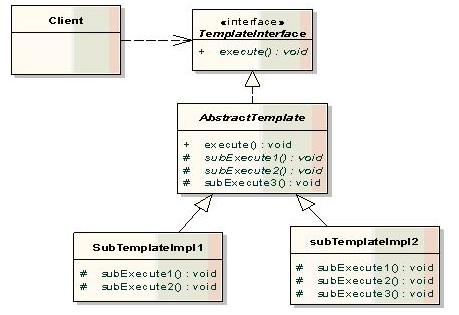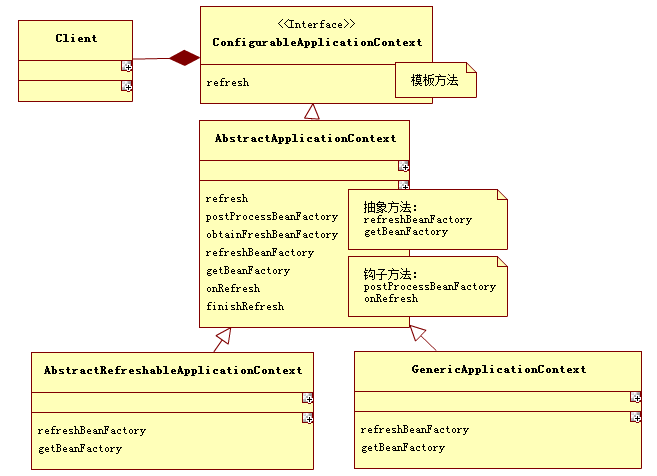設計模式——Spring IoC中用到的模板方法模式
http://www.cnblogs.com/gnidoc/p/4981447.html
基本概念
什麼是模板方法(Template method):父類定義了骨架(呼叫哪些方法及順序),某些特定方法由子類實現。
最大的好處:程式碼複用,減少重複程式碼。除了子類要實現的特定方法,其他方法及方法呼叫順序都在父類中預先寫好了。
所以父類模板方法中有兩類方法:
1、共同的方法:所有子類都會用到的程式碼
2、不同的方法:子類要覆蓋的方法,分為兩種:
A、抽象方法:父類中的是抽象方法,子類必須覆蓋
B、鉤子方法:父類中是一個空方法,子類繼承了預設也是空的
注:為什麼叫鉤子,子類可以通過這個鉤子(方法),控制父類,因為這個鉤子實際是父類的方法(空方法)!
模板方法模式,和現實中的模板很像,一個文件的模板通常是一個完成了部分內容的表格(表格模板就像一個模板方法),每個人都會拿到表格的副本(具體的實現類)進行某些項的填寫,每個人都可以對指定項(抽象方法或鉤子方法)進行填寫,表格中的必填項就像抽象方法必須實現,表格中的非必填項就是鉤子方法。當然只是比喻和實際情況不完全一樣。
UML圖

Java程式碼展示
下面的程式碼展示了,模板方法模式在Java程式碼中通常是怎樣的:
1、先定義一個介面,主要是定義了模板方法
public interface TemplateInterface {
public void execute();
}2、抽象類實現了介面,主要是實現了模板方法的邏輯,模板方法中呼叫了自己的邏輯方法,還有最重要的鉤子方法和抽象方法
public abstract class TemplateAbstractClass implements TemplateInterface{
/**模板方法*/
@Override
public void execute() {
preDoSomething();
abstractMethod();
hookMethod();
afterDoSomething();
}
private void preDoSomething(){
System.out.println("before do some thing in abstract class");
}
private void afterDoSomething(){
System.out.println("after do some thing in abstract class");
}
/**抽象方法*/
public abstract void abstractMethod();
/**鉤子方法*/
public void hookMethod(){
}
}3、兩個子類,One只實現了抽象方法,Two實現了抽象方法並覆蓋了鉤子方法
public class SubClassOne extends TemplateAbstractClass{
/**抽象方法*/
@Override
public void abstractMethod() {
System.out.println("do another thing by subClassOne");
}
}
public class SubClassTwo extends TemplateAbstractClass{
/**抽象方法*/
@Override
public void abstractMethod() {
System.out.println("do another thing by subClassTwo");
}
/**鉤子方法*/
@Override
public void hookMethod() {
System.out.println("hook method in subClassTwo");
}
}
Spring中的模板方法模式
Spring中幾乎所有的擴充套件,都使用了模板方法模式,JdbcTemplate中應該很多,不過還沒學到那裡,這裡說下IoC部分的模板方法模式!
注:貌似在業務系統中很少看到,是開發者的編碼能力問題還是對實際情況不適用,但是在框架中很多,Java IO、Spring、Hibernate等,可能是作為一個框架來說考慮更多的是擴充套件問題!
下面的程式碼展示了Spring IOC容器初始化時運用到的模板方法模式。(擷取部分關鍵程式碼)
1、首先定義一個介面ConfigurableApplicationContext,宣告模板方法refresh
public interface ConfigurableApplicationContext extends ApplicationContext, Lifecycle, Closeable {
/**聲明瞭一個模板方法*/
void refresh() throws BeansException, IllegalStateException;
}
2、抽象類AbstractApplicationContext實現了介面,主要實現了模板方法refresh(這個方法很重要,是各種IOC容器初始化的入口)的邏輯
public abstract class AbstractApplicationContext extends DefaultResourceLoader
implements ConfigurableApplicationContext, DisposableBean {
/**模板方法的具體實現*/
public void refresh() throws BeansException, IllegalStateException {
synchronized (this.startupShutdownMonitor) {
// Prepare this context for refreshing.
prepareRefresh();
//注意這個方法是,裡面呼叫了兩個抽象方法refreshBeanFactory、getBeanFactory
// Tell the subclass to refresh the internal bean factory.
ConfigurableListableBeanFactory beanFactory = obtainFreshBeanFactory();
// Prepare the bean factory for use in this context.
prepareBeanFactory(beanFactory);
try {
//注意這個方法是鉤子方法
// Allows post-processing of the bean factory in context subclasses.
postProcessBeanFactory(beanFactory);
// Invoke factory processors registered as beans in the context.
invokeBeanFactoryPostProcessors(beanFactory);
// Register bean processors that intercept bean creation.
registerBeanPostProcessors(beanFactory);
// Initialize message source for this context.
initMessageSource();
// Initialize event multicaster for this context.
initApplicationEventMulticaster();
//注意這個方法是鉤子方法
// Initialize other special beans in specific context subclasses.
onRefresh();
// Check for listener beans and register them.
registerListeners();
// Instantiate all remaining (non-lazy-init) singletons.
finishBeanFactoryInitialization(beanFactory);
// Last step: publish corresponding event.
finishRefresh();
}
catch (BeansException ex) {
// Destroy already created singletons to avoid dangling resources.
destroyBeans();
// Reset 'active' flag.
cancelRefresh(ex);
// Propagate exception to caller.
throw ex;
}
}
}
這裡最主要有一個抽象方法obtainFreshBeanFactory、兩個鉤子方法postProcessBeanFactory和onRefresh,看看他們在類中的定義
兩個鉤子方法:
protected void postProcessBeanFactory(ConfigurableListableBeanFactory beanFactory) {
}
protected void onRefresh() throws BeansException {
// For subclasses: do nothing by default.
}
再看看獲取Spring容器的抽象方法:
/**其實他內部只調用了兩個抽象方法**/
protected ConfigurableListableBeanFactory obtainFreshBeanFactory() {
refreshBeanFactory();
ConfigurableListableBeanFactory beanFactory = getBeanFactory();
if (logger.isDebugEnabled()) {
logger.debug("Bean factory for " + getDisplayName() + ": " + beanFactory);
}
return beanFactory;
}
protected abstract void refreshBeanFactory() throws BeansException, IllegalStateException;
public abstract ConfigurableListableBeanFactory getBeanFactory() throws IllegalStateException;
具體要取那種BeanFactory容器的決定權交給了子類!
3、具體實現的子類,實現了抽象方法getBeanFactory的子類有:
AbstractRefreshableApplicationContext:
public abstract class AbstractRefreshableApplicationContext extends AbstractApplicationContext {
@Override
public final ConfigurableListableBeanFactory getBeanFactory() {
synchronized (this.beanFactoryMonitor) {
if (this.beanFactory == null) {
throw new IllegalStateException("BeanFactory not initialized or already closed - " +
"call 'refresh' before accessing beans via the ApplicationContext");
}
//這裡的this.beanFactory在另一個抽象方法refreshBeanFactory的設定的
return this.beanFactory;
}
}
}
public class GenericApplicationContext extends AbstractApplicationContext implements BeanDefinitionRegistry {
@Override
public final ConfigurableListableBeanFactory getBeanFactory() {
//同樣這裡的this.beanFactory在另一個抽象方法中設定
return this.beanFactory;
}
}
其實這裡的差別還不是很大,我們可以看看另一個抽象方法refreshBeanFactory的實現,兩個抽象方法的配合使用。
所以這裡的UML是:


